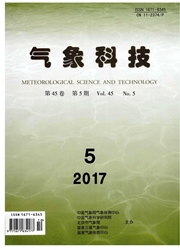

 中文摘要:
中文摘要:
基于1994—2014年研究区葡萄的逐年商品果率数据,1965—2014年芜湖市逐月的气象数据和1981年7月至2014年6月国家气候中心的逐月88项新大气环流指数、26项海温指数,使用相关性分析、线性趋势、MannKendall和多元逐步回归分析,对影响葡萄商品果率的关键气候因子进行遴选,并在此基础上对遴选因子的近50年变化特征和短期气候预测进行了分析与研究。结果表明:影响葡萄商品果率的关键气候因子有7、8月的平均气温(T7,T8)、最高气温(T(max7),T(max8))、最低气温(T(min7),T(min8))、相对湿度(R(H7),R(H8))、日照时数(S7,S8),以及8月的平均气温日较差(ΔT8),近50年T7、T(max7)和T(min7)显著升高,RH7、ΔT8和S8显著下降,其中T7、T(max7)、ΔT8的变化以渐变为主,而T(min7)、R(H7)、ΔT8则发生过突变。这些关键气候因子与前期1年内的多项大气环流指数和海温指数显著相关,并遴选其中关键指数作为预测芜湖市7、8月葡萄商品果率关键气候因子的短期气候预测指标,计算出气候因子的预测方程,以期为葡萄种植能够有效应对气候影响、保证商品果率提供帮助。
 英文摘要:
英文摘要:
Using the data of the rate of marketable fruits from 1994 to 2014in the study area,the monthly meteorological data in Wuhu from 1965 to 2014,88 new monthly general circulation indexes from July1981 to June 2014 and 26SST indexes from the national climate center,based on correlation analysis,linear trend analysis,Mann-Kendall,and stepwise multiple regression analysis,the key climatic factors influencing the rate of marketable fruits are chosen.On this basis,the characteristics and predictions of the chosen climatic factors are analyzed.The results show that the key influence climatic factors include monthly average temperature(T7,T8),monthly average maximum temperature(T(max7),T(max8)),monthly average minimum temperature(T(min7),T(min8)),monthly average relative humidity(R(H7),R(H8)),monthly average sunshine duration(S7,S8)in July and August,monthly average daily temperature range(ΔT8)in August.In nearly 50 years,T7、Tmax7,and Tmin7 raised significantly,but R(H7)、ΔT8,and S8 dropped significantly.T7、T(max7)、ΔT8 showed a gradual feature,and T(min7)、R(H7)、ΔT8 changed suddenly.These key climatic factors were significantly correlated with many general circulation indexes and SST indexes in previous 12 months,from which key indicators are chosen as the short-term climatic forecast indexes of the key climatic factors influencing the rate of grape marketable fruits in July and August in Wuhu,and the predicting equations of the key climatic factors are worked out.This study can provide references for grape planting in dealing with the impacts of climate change effectively.
 同期刊论文项目
同期刊论文项目
 同项目期刊论文
同项目期刊论文
 期刊信息
期刊信息
